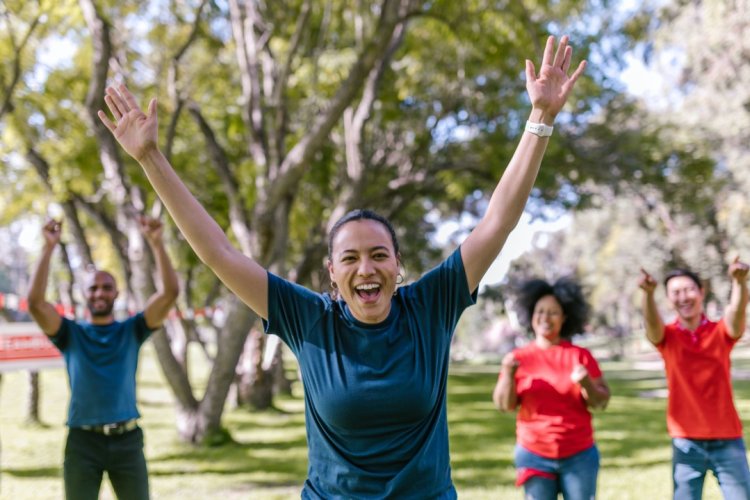Building a Happy Team: The Power of Team Building Exercises
Chewi |Oct 20, 2023
In this article, we will explore why team happiness is essential, and how team-building exercises can be a valuable tool to achieve this goal.
Table of Contents
A happy and cohesive team is a cornerstone of success for any organization. When your team is content, motivated, and working together harmoniously, productivity soars, and everyone benefits. Team building exercises play a pivotal role in creating a happy and effective team. In this article, we will explore why team happiness is essential, and how team-building exercises can be a valuable tool to achieve this goal.

The Importance of Team Happiness
Team happiness is not just a warm and fuzzy concept; it has concrete benefits for both the team members and the organization as a whole. Here are some key reasons why fostering team happiness is crucial:
Improved Productivity: Happy team members are more motivated, engaged, and willing to go the extra mile. This results in increased productivity and better outcomes for the organization and casino.
Enhanced Communication: A team that is happy and comfortable with one another communicates more effectively. They are more likely to share ideas, resolve conflicts, and work together harmoniously.
Better Problem Solving: Happy teams tend to be more creative and innovative. They are more likely to brainstorm and develop creative solutions to challenges.
Employee Retention: Content team members are less likely to leave the organization, reducing turnover rates and the associated costs of recruitment and training.
Stronger Team Bond: Team happiness fosters a sense of belonging, trust, and camaraderie among team members. This can improve cooperation and collaboration.
Team Building Exercises: A Tool for Happiness
Team building exercises are structured activities designed to improve team dynamics, enhance communication, and strengthen bonds among team members. These exercises come in various forms, from outdoor adventures to indoor problem-solving activities, and can be customized to suit the specific needs of your team. Here are some effective team building exercises and how they contribute to team happiness:
Icebreakers: Icebreakers are short, simple activities designed to help team members get to know each other better. By creating a comfortable and open atmosphere, icebreakers pave the way for deeper connections among team members, which is essential for team happiness.
Trust-Building Activities: Trust is a foundational element of team happiness. Trust-building exercises, such as trust falls or trust walks, help team members develop trust in one another. As trust grows, so does team unity and happiness.
Problem-Solving Challenges: Problem-solving exercises, such as escape rooms or puzzle games, encourage collaboration and creativity. These activities can be enjoyable while also fostering teamwork and a sense of accomplishment when the team successfully solves a challenge.
Team Bonding Outings: Taking the team out for an enjoyable outing, such as a hiking trip, a visit to an amusement park, or a team picnic, can help team members relax, have fun, and build lasting memories. These shared experiences can strengthen team bonds and happiness.
Communication Workshops: Effective communication is vital for team happiness. Communication workshops and exercises can help team members improve their listening, speaking, and non-verbal communication skills, leading to clearer and more productive interactions.
Team Competitions: Friendly competitions, such as sports events or quiz contests, can boost team morale and provide a sense of achievement when working together as a cohesive unit.
Role Reversal Exercises: Role reversal activities encourage team members to step into one another's shoes. This fosters empathy, understanding, and a more profound appreciation for each other's roles and challenges, contributing to a happier team.
Appreciation and Recognition: Encourage team members to express their appreciation for one another through exercises like "appreciation circles" or written notes of gratitude. Feeling valued and recognized enhances overall team happiness.
Tips for Effective Team Building Exercises
While team-building exercises are a valuable tool, they should be executed thoughtfully to maximize their impact on team happiness. Here are some tips for ensuring the success of these activities:
Understand Your Team: Tailor team-building exercises to the needs and preferences of your specific team. Consider factors like the team's size, goals, and any challenges they may be facing.
Encourage Participation: Ensure that all team members feel comfortable participating in the exercises. Avoid activities that might make individuals feel excluded or uncomfortable.
Debriefing and Reflection: After each exercise, conduct a debriefing session to discuss what was learned and how it can be applied to the team's work. Encourage team members to reflect on their experiences.
Consistency: Team building exercises should not be isolated events. Integrate them into your team's routine to reinforce the values and lessons learned.
Measure Impact: Assess the effectiveness of team building exercises by tracking changes in team dynamics, communication, and happiness over time. Use surveys, feedback sessions, or performance metrics to gauge progress.
- Tag






Comments
Sort by Newest | Popular